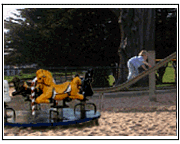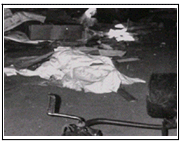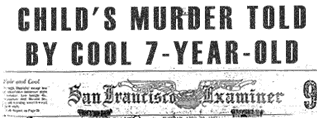
When a 6-year-old boy nearly beat to death a neighbor's infant in the spring of 1996 in a neighborhood near San Francisco, it was a jolting flashback for many who recalled a crime in the Bay Area 26 years earlier.
The "crucifixion murder"
Spring, 1971. The camera shutter clicks on an innocent childhood scene: two boys in a playground, playing on swings, goofing around in the sandlot, walking hand-in-hand with a toddler in blue sneakers and a red-and-white striped t-shirt.
But the image shifts. The next snapshot is horrific: Two boys in a basement. Kicking and stomping the toddler. Beating him with a brick. Tying him naked to a makeshift wooden cross and leaving him to die.
It became known as 'the crucifixion murder' and two young brothers -- seven and 10 years old -- confessed to killing the 20-month-old child they had met in a park.
How did the public and police react to such an incident back then? And what became of those two boys?
Drawing on exclusive FRONTLINE interviews, police reports and local newspaper accounts, here is the story of this crime a quarter century ago and the two boys -- then and now.
Ten year-old "Bobby" and seven year-old "Billy" lived with their father, a vocational school student and former shipyard worker who was separated from his wife. He gave Bobby and Billy bus passes to visit their mother across town and described them as "pretty free-wheeling kids." They were used to walking the streets alone, sometimes for miles away from home.
The father, the two boys, and a younger son lived in a four-bedroom railroad flat in Pacific Heights not far from Alta Plaza Park. It was a rough neighborhood. Both older boys had witnessed robberies and muggings, "all the nasty stuff the city has to offer," their father told reporters. The boys claimed they had often been beaten up by neighborhood kids.
Billy, the 7-year-old, had fallen down an airshaft two years earlier and required
surgery for a plastic plate to be attached to his skull. Bobby witnessed the accident and watched as his brother lingered between life and death, then recovered.
The boys were close and often played together. Sometime in the early afternoon of April 14, 1971 they wandered down to the park, where they played on swings and in the sandlot.
 Melanie Alba, a 21-year-old mother of two, told reporters she was keeping an eye on her children at the park while sunbathing on grass nearby. Noah, a blue-eyed, blonde-haired toddler was easy to spot in his green Levis, but small enough at 30 pounds and 25 inches tall to just as easily lose track of.
Melanie Alba, a 21-year-old mother of two, told reporters she was keeping an eye on her children at the park while sunbathing on grass nearby. Noah, a blue-eyed, blonde-haired toddler was easy to spot in his green Levis, but small enough at 30 pounds and 25 inches tall to just as easily lose track of.
About 2 p.m., his sister Symanie returned to Melanie alone, her brother
missing. As Melanie recalled at the time, "One moment he was playing nearby...then he was gone."
 The two brothers had found 20-month-old Noah wandering alone. In his 1997 interview with FRONTLINE, Bobby said they asked the child where his mother was and when he couldn't tell them, they took the youngster by the hand and led him through the park asking various strangers if they knew his mother. No one did.
The two brothers had found 20-month-old Noah wandering alone. In his 1997 interview with FRONTLINE, Bobby said they asked the child where his mother was and when he couldn't tell them, they took the youngster by the hand and led him through the park asking various strangers if they knew his mother. No one did.
A witness in the park told the mother and later investigators he saw two
boys leading a child by the hand out of the park.
A brutal crime
Bobby, who is now in his 30s and spoke to FRONTLINE on the condition of
anonymity, said he and his brother had had no plan.
"A block-and-a-half away, we had a little spot that me and Billy had been
to a couple of times. It was underneath a building, it was kind of like a fort area, [a] little play area that we happened upon in our adventures," he recalled. "We went down there and just stayed there for awhile and played around...That's pretty much what I can recall at first. We were just playing around."
As detectives would learn days later, the brothers had taken Noah down an alley and into a dingy, unfinished basement used as a "clubhouse" by neighborhood children. There wasn't much to speak of: peeling columns, two old mattresses, a red bicycle, broken cafe chair, shattered glass and pieces of wood.
According to Bobby, little Noah Alba began crying in the dark, decrepit space. The boys tried to get him to stop. Growing increasingly agitated, Bobby said he thinks he slapped the baby and his brother joined in. The crying grew louder and the violence became worse until the child lay still.
"I think the most disturbing visual memory I have is seeing a bruised baby, and it wasn't moving," Bobby told FRONTLINE. "That was the one thing that I've tried real hard not to remember, but that's the visual I get."
Police later told reporters it was more than slaps that killed Noah. They said the boys pounced up and down on the baby and furiously hit him with a brick, cutting his head open and exposing his skull. The cause of death was a ruptured liver with internal bleeding.
For five days following Noah's disappearance, police scoured every district in the city. A handball glove spotted by a witness on one of the boys seen leaving the park with the toddler proved to be the vital clue. Police spread the description and a schoolteacher who knew that one of the brothers often wore a handball glove alerted investigators to his identity.
Police said Billy led them to the dead child.
"So I asked [the 7-year-old], if you were a policeman on this case, where would you look,...what would you do?" San Francisco Detective Dan Driscoll told reporters. The youngster responded, "I would look in an alley," Driscoll said.
 The boy led police to an alley and pointed to a basement door, suggesting they "try in there." Driscoll spotted Noah's naked body in a corner, his arms and feet lashed to a crude wooden cross and covered in paper and debris. A bloody shirt lay next to him. The detective told reporters he spun Billy around and back out the door to spare him the terrible sight.
The boy led police to an alley and pointed to a basement door, suggesting they "try in there." Driscoll spotted Noah's naked body in a corner, his arms and feet lashed to a crude wooden cross and covered in paper and debris. A bloody shirt lay next to him. The detective told reporters he spun Billy around and back out the door to spare him the terrible sight.
Once the police discovered the child, both boys confessed to assaulting the toddler. They said they were playing with Noah when a brick accidentally fell on his head. They explained that they took off the baby's clothes when he wet his diapers and tied him to the cross so he couldn't escape, police said.
Bobby told FRONTLINE that the cross formation, which had mystified police and the public, grew out of his knowledge of Jesus Christ and a naive belief that the baby could be resurrected, too.
"The only thing I could think of [was] I really didn't mean to do this, I didn't want this to happen," he said in his interview. "I don't remember being very religious, but I felt like [putting the baby on a cross] was the only thing to do...I wanted the baby back alive. I wasn't absolutely sure it was dead, but it wasn't moving and it was bruised.
"So I put it in a cross formation, and I hoped," he said, adding, "I don't think I really gave up hope until the police officers found it."
Child or monster?
The police had their suspects, but the question of what to do with such young boys was bewildering, according to investigators who had worked on the case. How do you read a 7-year-old his Miranda rights? And how do you prove premeditation in child's play?
Some labeled the two boys "monsters." A San Francisco paper ran the headline, "CHILD'S MURDER TOLD BY COOL 7-YEAR-OLD." But little Noah Alba's gruesome slaying was an anomaly. In 1971, juvenile arrests in California were on the decline. Few could imagine children killing children, particularly in the waning era of Haight-Ashbury flower children and psychedelia. Even fewer could grasp the idea of charging a 7- and 10-year-old with homicide.

Public reaction on the whole was one of sorrow and even cautious hope for the boys. Some wondered if drugs were to blame. John Fotinos, a San Francisco homicide
detective who assisted in the investigation, said he felt the brothers were not vicious.
"[Kids] need supervision, period, and apparently these guys ran amok, and it's not their fault, really," Fotinos told FRONTLINE. "I think it would be criminal to [incarcerate] a 7-year-old and a 10-year old...We don't even do that to animals, for crying out loud."
Even the victim's mother expressed no anger and assigned no blame.
"To kids, what's the difference between doing a thing like this or kicking
a puppy?" she told reporters, tears streaming down her face minutes after identifying her baby's mutilated body at the morgue.
A gag order banned discussion of the case outside the courtroom, and media
attention quickly dissipated. Bobby, the 10-year-old, spent two months in juvenile detention before murder charges against the two brothers were dismissed by a juvenile court judge in favor of therapy. The judge ordered them placed in a special home, where for two years they received extensive counseling and psychotherapy before being returned to their mother's custody. Their names were never made public.
The dual aftermath
Bobby has gone on to live a responsible life, working and raising a family of his own. Billy, however, has had minor run-ins with the law as a juvenile and struggled with substance abuse. As an adult, he has been convicted twice of physically abusing children -- including his own 3-month-old son and another child, police and court records show.
In his interview with FRONTLINE, Bobby said he has told very few people about his past.
The brothers' relationship is still close, Bobby said, and he can only guess that his brother suffered more because he was younger and more impressionable. He tries not to dwell on what they did.
"It's hard for me to think of me, today, as the person that did this horrible thing," he said. "I'm a productive citizen. I'm doing well as a father, I'm doing well as a worker. I make a living for myself and my family...I take care of myself well and try not to hurt anybody and try to live by the laws of the land, so to speak."
The experiences of Bobby and Billy reflect what experts have generally observed about the rehabilitation of troubled young children. Given intervention at an early age, roughly half go on to lead responsible lives; the other half experience serious psychological and social problems. Researchers say there are no clear explanations for why one group succeeds and another fails. Some speculate that a strong relationship with a mentor or caring adult can be a critical factor in changing a child's life.
Looking back, Bobby is still very troubled that his brother has led a different kind of life. As the older brother, he feels that Billy had looked to him as a role model and followed his lead. It's hard for Bobby to understand the way that things have worked out and "at the core," he says, "Billy is a good person."
Debate today is increasingly focusing on how to handle troubled children and set them straight while protecting society from the ones who seem most lost. Most states have lowered the age at which juveniles are charged as adults, making it possible for convicted youths to be sent to adult prisons.
Some people say treating a violent child as a child is not worth the risk to society and changing violent, antisocial behavior is an impossibility. But childrens' rights activists and many legal and mental health professionals disagree, arguing that a child can be helped with the right intervention. Bobby agrees.
"I was a child. Everybody was a child at one time, and people change," he said. "People with the right direction can change in the right direction over time. I feel if I were locked up for an adult term for what I did I would be a much harder person."
At the same time, Bobby also says that it was important for him to take responsibility for what happened: "I can say that I lived in a bad environment and that it was really, really, really rough. And maybe that helped the situation...But how can I blame that? I did it.....I can't blame my parents...
"I still feel like looking back it was still me and if I were to try and direct that anger off to somebody else and not deal with it, I don't feel like I would ever deal with it. "